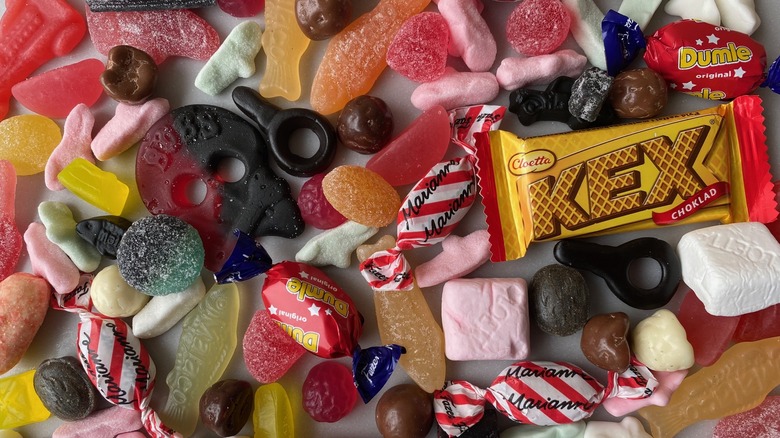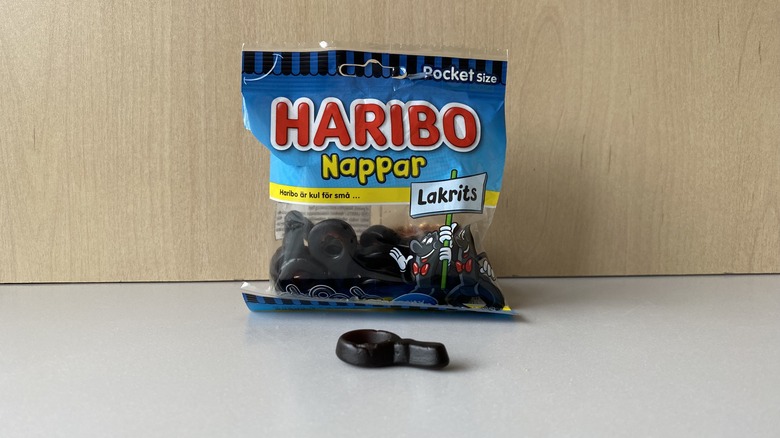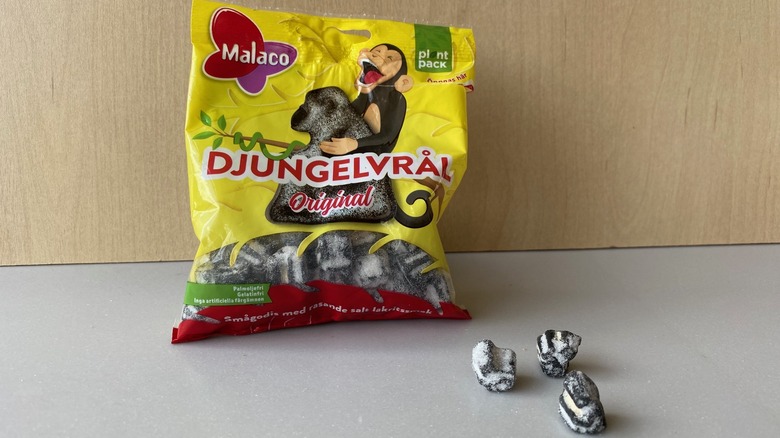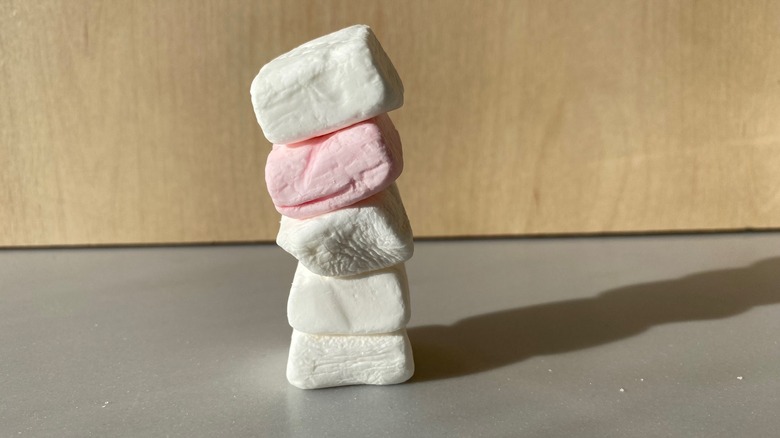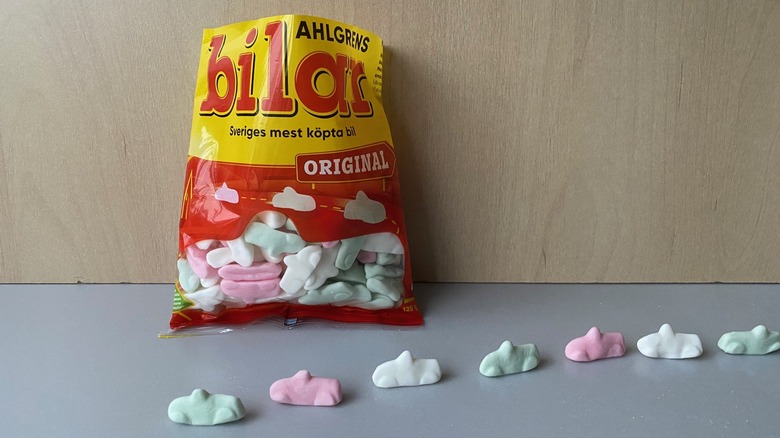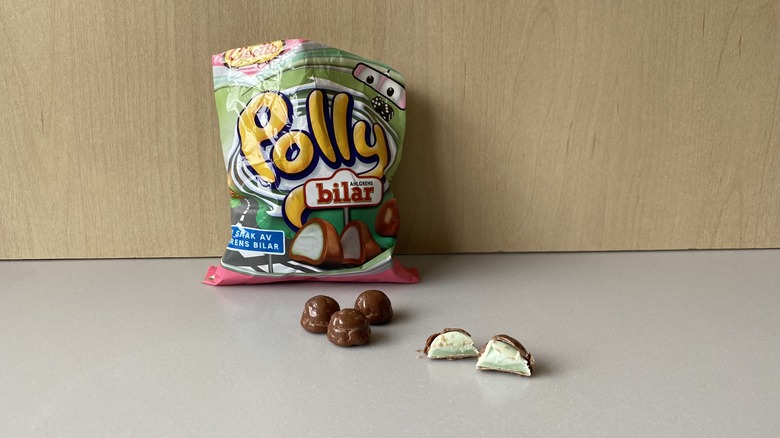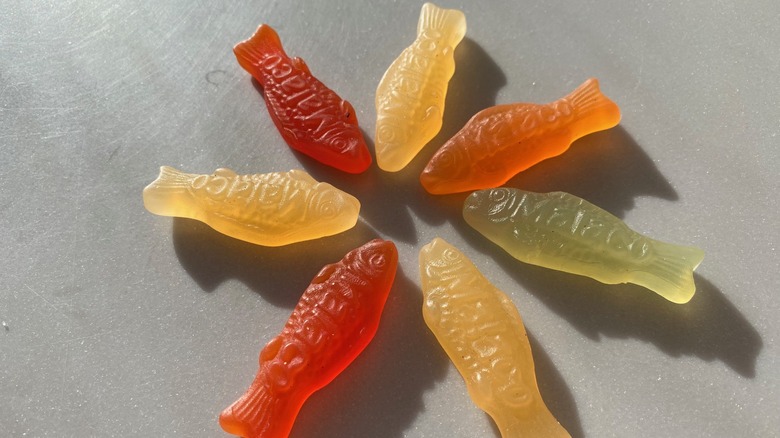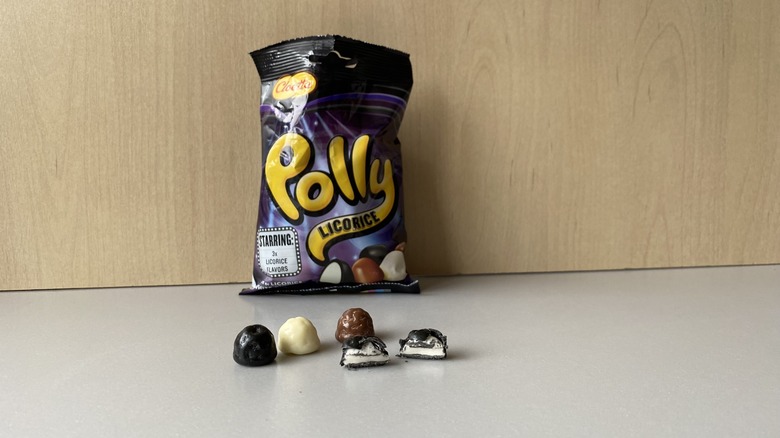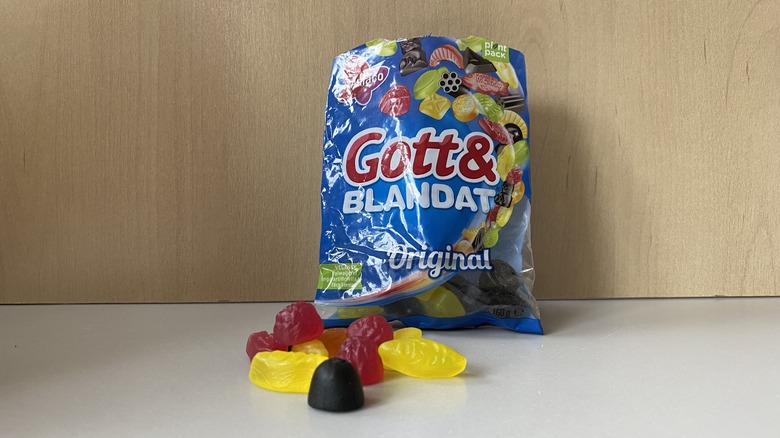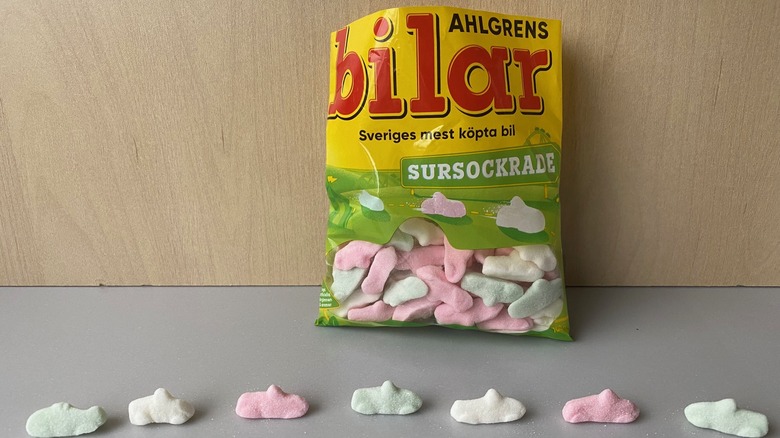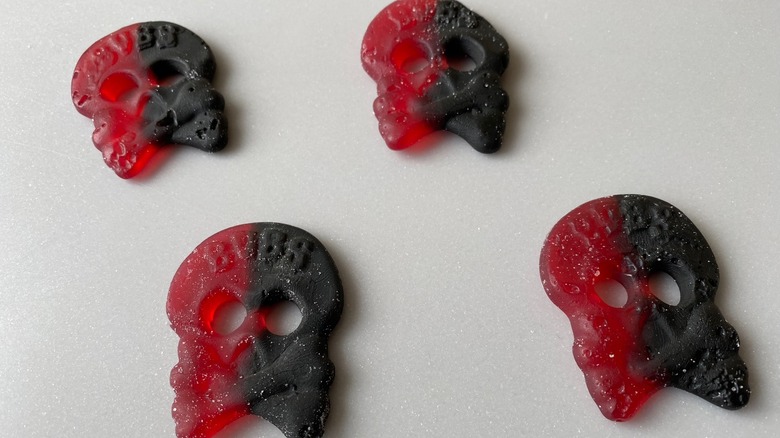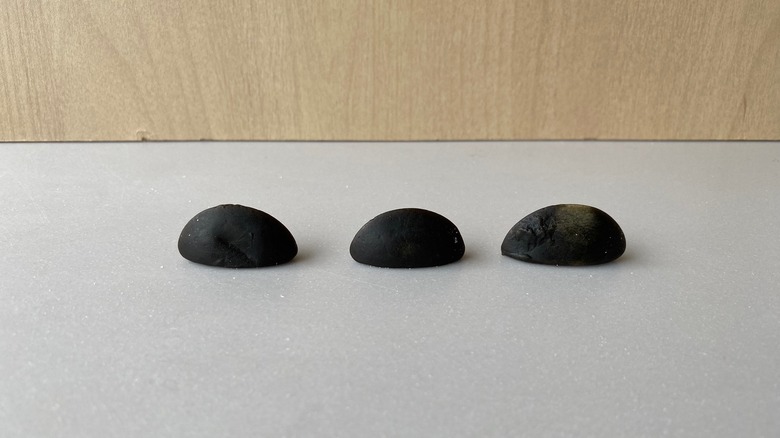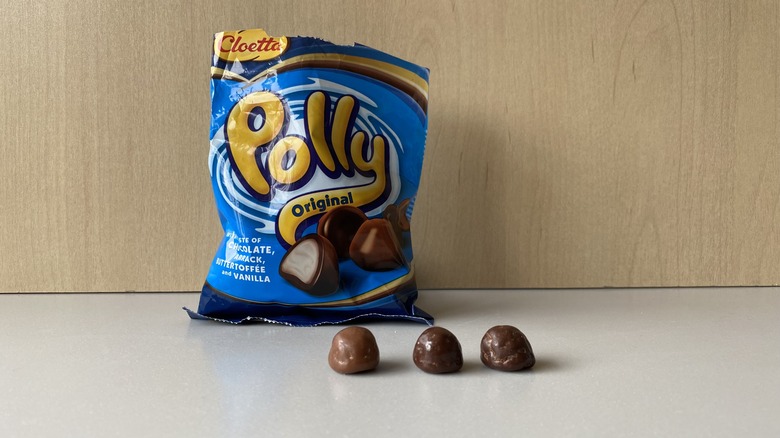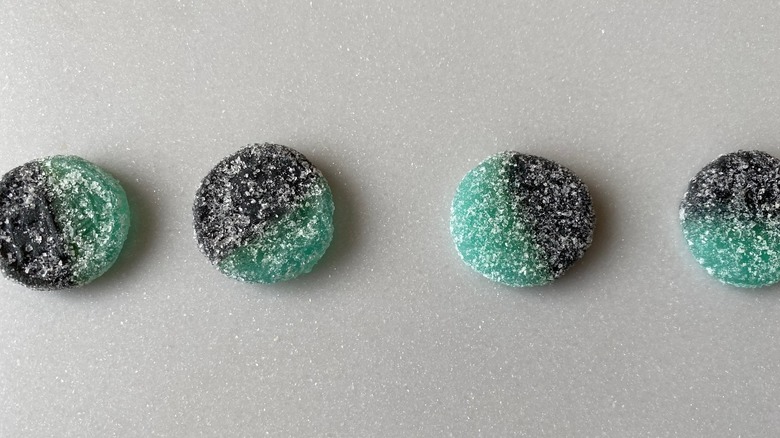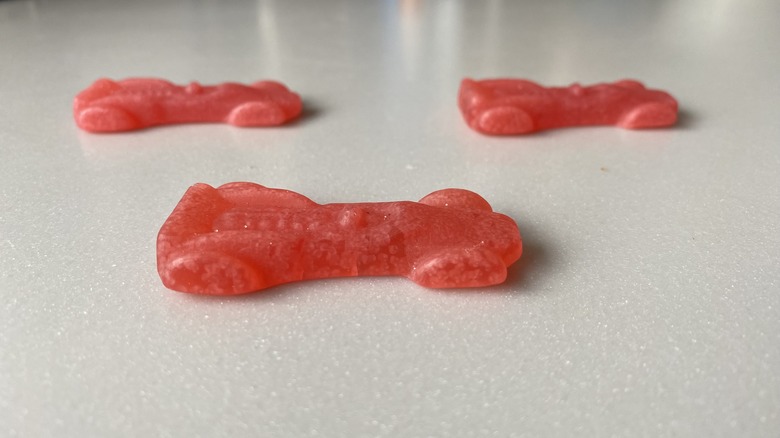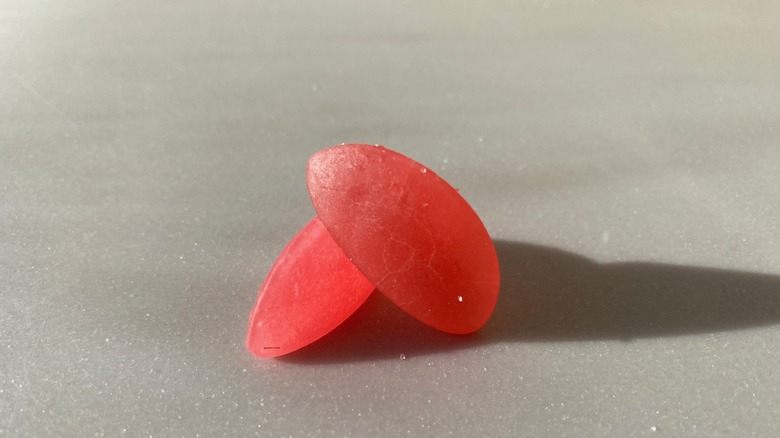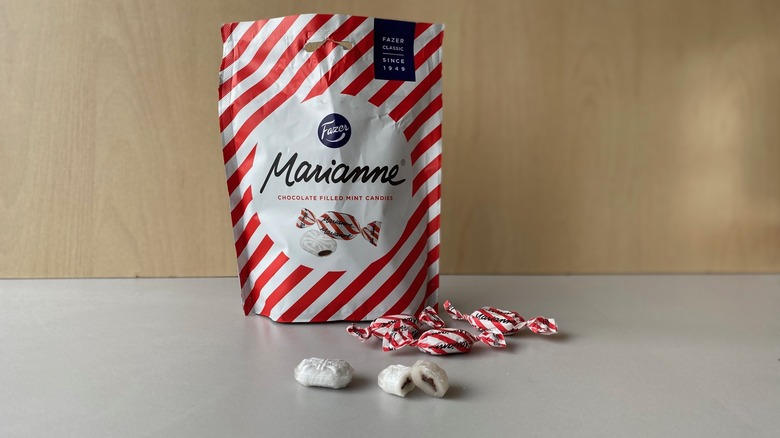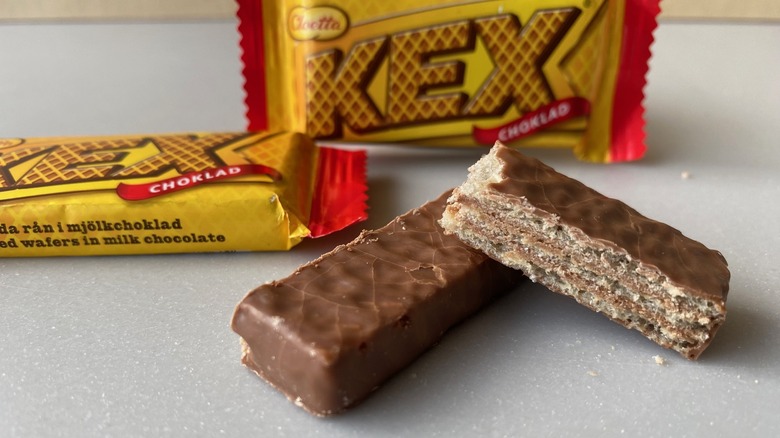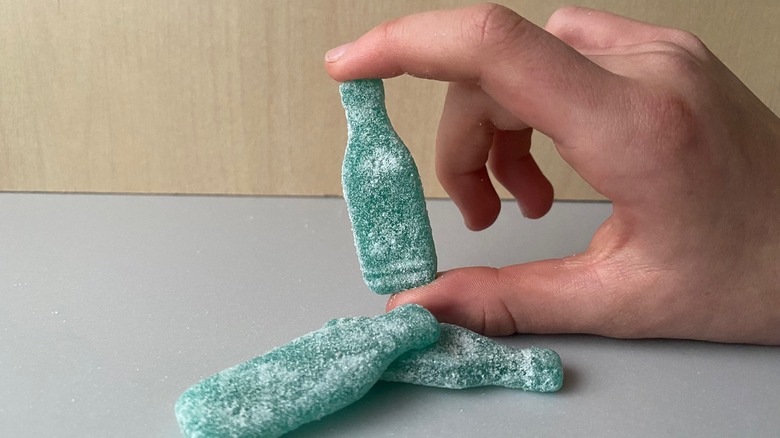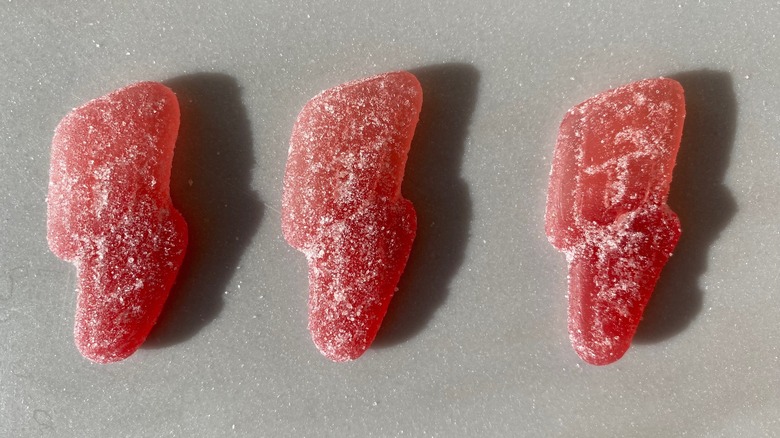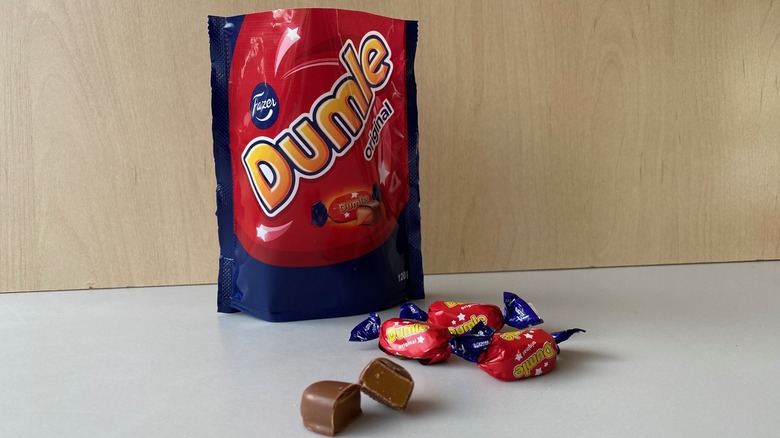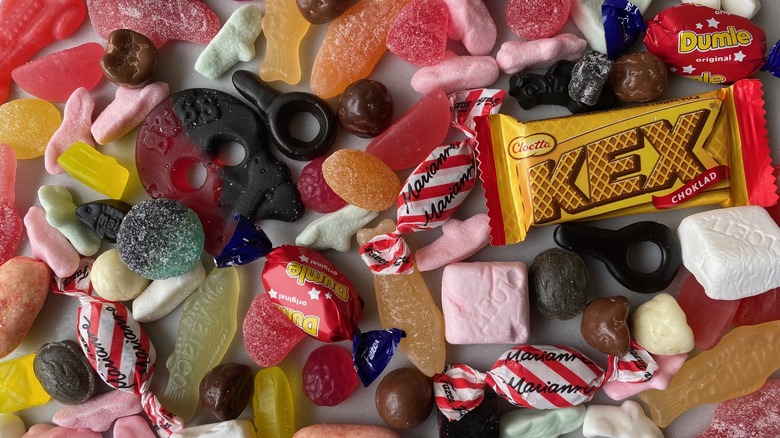21 Popular Swedish Candies, Ranked Worst To Best
In Swedish culture, candy is more than just a vehicle for sugar; it's a dedicated weekly cultural ritual that brings people together. It's so woven into Swedish life that, according to Scandinavia Standard, the average Swede consumes over 37 pounds of sweets per year.
In Sweden, Friday afternoons and evenings are set aside from the rest of the week as Fredagsmys, or "cozy Fridays." This ritual is about slowing down, enjoying a meal, and heading to the lösviktsgodist, a pick 'n' mix candy shop. Saturdays are when adults and children enjoy the lördagsgodis, which translates to "Saturday sweets." Though there are no set restrictions on eating sweets during the week, this structure is largely adhered to because of the Swedish government's initiative in the 1950s to reduce tooth decay.
Recently, Swedish candy has seen a considerable uptick in the United States, thanks to TikTok, which brought this Swedish ritual to an entirely new audience. Here are some of my thoughts on the flavor and consistency of the country's most popular sweets, which I researched through various media outlets. The selection included both pre-packaged sweets and pick 'n' mix selections of sweet, sour, and licorice candies. I also sought the help of my two children for this taste test. Who could resist lördagsgodis to break up the weekly routine?
21. Haribo Nappar
These pacifier-shaped candies, known in Swedish as "nappar," are popular in Sweden's candy culture. Haribo first created the now-popular shape and explicitly launched it in the Swedish market in 1961. Nappars come in various flavors, including licorice, cola, marshmallow, and various fruits. The shape makes it fun to hold since you can put your finger through the ring and treat the end like a pacifier. Unfortunately, this slightly salty licorice flavor and teeth-sticking texture couldn't win me over, especially when I was dreaming of all the other possible flavors I could have had instead.
After just one nappar, my palate was tapped out of flavor. While this makes the purchase economical, since I didn't have the urge to devour the entire packet in one sitting (which I likely would with the fruit flavors, especially if it was a bit sour), it does take away from the enjoyment that comes with the treat-like qualities of a packet of sweets.
20. Djungelvrål Original
Djungelvrål by Malaco are unassuming little monkey-shaped black licorice candies coated in salt. Swedes have been feasting on these in-your-face candies since they were first released in 1982. These candies pack a punch of both salt and licorice. However, for those unaccustomed to this traditionally Swedish flavor pairing, this candy could be incredibly overwhelming with its extra helping of salt.
I did like the additional texture the salty coating provided, but the taste was just not for me; it was too much salt followed by too much licorice. No wonder the monkey on the packet looks a bit menacing, laughing at whoever took the bait of a salt lick-punch in the mouth, disguised as a cute little sweet. However, I acknowledge that this is not a flavor combination I'm used to. Others love it, which is why the candy flavor has been going strong for over 40 years.
19. Sockerbitar
These are marshmallows, but not as Americans know them. Rather than the overstuffed and fluffed cloud-like marshmallows Americans toast over a campfire, Swedish marshmallows, or sockerbitar, are all about chewiness. Think about what would happen if the pull and chew of salt water taffy were combined with the vanilla flavor of a marshmallow, with almost a dehydrated texture. The result is as close as I can describe to the sockerbitar experience. It's fun, almost foam-like, and delivers on sweetness.
Just like the puffed-up American version, pairing these with a piece of dark chocolate would be a match made in heaven, and they tick all of the texture boxes, too. While these were completely inoffensive, my children and I preferred the fluffy American marshmallow to its stretchier Swedish cousin.
18. Ahlgrens Bilar Original
Bilar, meaning "cars" in Swedish, is a popular candy in the country. It is so popular that the product's tagline, which is probably also true, states that it is the most purchased car in all of Sweden. Bilar is one of many vehicle-related sweets, as the country has quite a few (including cars, boats, and Ferraris). These fruity, floral, marshmallowy cars are pleasingly chewy, if not overly flavored, for such a compact little car.
The car's flavor and shape have remained virtually untouched since the product's original creation in the 1950s. While the original recipe remains the same, the brand has brought new products to market, including sour and salted licorice. While I wasn't a massive fan of the flavor, my children begged to eat them by the handful, which says something about the brand's success over 70 years later.
17. Polly Bilar
Thanks to the Finnish company Cloetta, a wide variety of Polly candies are circulating in the Swedish market. Cloetta certainly has a strong foothold in the Scandinavian candy market, with products across Sweden, Finland, the Netherlands, Denmark, and Norway. Cloetta also manufactures other popular confections like Gott & Blandat. This Polly Bilar is probably a crossover that combines two of the country's most popular candies, Polly and Ahlgrens Bilar, creating one milk chocolate-coated candy with a fruity, foamy center.
Unfortunately, I was just lukewarm about this collaboration. While I like the glossy, chocolaty, hard coating, I wasn't a fan of the overly perfumed center. I much prefer the other flavors of Polly eaten in the name of research for this piece, but in principle, I can see its appeal to customers who love the original Ahlgrens Bilar.
16. Lakridsfiskar
Thank goodness actual Swedish fish, or Lakridsfiskar, taste much better than the red version found in the U.S. Lakridsfiskar comes in a wide variety of flavors rather than being limited to the so-called lingonberry flavor. Though the salted licorice variety is probably more of an acquired taste, it is prevalent among the candy-buying consumers of Sweden. There are other flavors, like orange, pineapple, and lemon, as well as sour and fizzy versions, too. Rather than the lingonberry flavor of the ubiquitous red fish, which is indistinguishable unless you've been made aware of the flavor, the green-hued pineapple fish clearly tastes like pineapple while the lemon one tastes like lemon.
Lakridsfiskar is considered a wine gum rather than a gummy because it lacks gelatine. Therefore, no matter which flavor you choose, eating one will require good tooth brushing or flossing afterward. While the pineapple stood out as a top flavor, overall, we found these slightly unmemorable compared to other candies we sampled.
15. Polly Licorice
This candy is perfect for anyone looking to get their start in the salted licorice world. Polly licorice candy is a chocolate-coated, lightly salted variety that comes in three flavors: licorice (black), milk chocolate (brown), and white chocolate (white). The combination worked a treat and left me casually reaching my hand back into the bag for more.
While all three flavors appealed to my palate, I liked the white chocolate and salted licorice candies the most. This is unusual for me because I don't consider myself a fan of white chocolate. However, the salt balanced out the white chocolate's sickly sweetness while giving it an earthy flavor.
Thankfully, the licorice was also subtle. The foam-like texture of the filling and the glossy coating were also appealing. While I probably won't purchase an entire bag again, I wouldn't turn them down if someone offered me a few, especially as part of lördagsgodis.
14. Gott & Blandat
Gott & Blandat are squishy candies bursting with fruity flavor. The fruits still taste artificial, but there's no mistaking the lemon or the raspberry for any other kind of berry. Rather than salty, the licorice is sweet. After all, the name means "good and mixed," which reflects the variety in each bag. While this selection was from the original flavor collection, Gott & Blandat also comes in other varieties, including soured and salted candies.
The only real downside to these sweets, other than the fact I only had two pineapples in our bag (which was arguably the best flavor in the original pack), was the candy's keen ability to get stuck in the teeth, to the point of needing a toothpick to excavate the gummy sweet from its new home inside my molar.
13. Geléhallon
A top pick 'n' mix option is these geléhallon (gumdrops). The most popular geléhallon flavor in Sweden seems to be raspberry. These sweet, squidgy, satisfyingly sugar-coated gumdrops have a vibrant color and flavor to match. You can scoop them into a sweet pick 'n' mix or buy them by the dedicated bagful. The appeal of these sweets is most assuredly their texture, featuring a soft inside and a crystalized sugar coating, which makes them incredibly satisfying to suck until smooth.
Unfortunately, the sweet flavor also had a slightly medicinal-like aftertaste, which made me wish it came in a different flavor, like green apple or watermelon. Despite this, these cheerful sweets were a pleasure to eat, and I can see why they are a popular item amongst children and grownups alike.
12. Bilar Sursockrade
Wow, these little foamy cars are sour and pack a punch! If you are considering buying a pack of these sweets to give to a young child, you might want to inquire about their penchant for sour things first. Otherwise, these might have the same effect as watching a child eat a lemon wedge.
The sour coating almost completely removes the overly floral and fruity flavor of the original bilar. While some might disagree, I consider this to be a good thing. While my children were convinced the three different colors were separate flavors, my tastebuds didn't agree. Though, if you like sour, foam-like candy, this one is for you. The punchy burst of sour flavor is what gave these sweets their appeal, which is why this variety has made it higher up on the list than the brand's original offering.
11. Skalle
Skalle (skulls) are a popular candy shape in Sweden and come in various sizes, from miniature to the large ones we sampled. Flavor combinations can vary from sweet to sour to salty and can often be found as a pick 'n' mix choice, as were these. Inside our licorice pick 'n' mix bag were four large, red and black gummy skulls from Swedish candymaker Bubs Godis.
I proceeded with caution when I realized the black would most assuredly be licorice-flavored. However, the combination of the raspberry and slightly salty licorice worked well together, and neither became overpowering. The texture was a bit tough, but the raspberry offset the licorice. Overall, this gummy is the best salted licorice I tried, which is why they are ranked so high.
10. Licorice PimPim
Here stands the gentlest of licorice candies. According to Vogue Scandinavia, Nordic countries, including Sweden, consume between 80 and 90% of all the world's licorice. Of course, the most popular form is salted rather than sweetened, a link that, though unproven, may be associated with other salt-preserved foods of the region, like pickled fish and cabbage.
Unlike many other licorice candies on this list, licorice PimPims are surprisingly sweet rather than salty. The candies are delightful in taste and texture, with a pleasant, chewy, smooth surface and a more jelly-like inside. For a non-Nordic consumer, these would probably be the easiest way to dip a toe into the wide world of licorice. While these lacked the salt component of the popular Nordic flavor, my non-licorice-liking children enjoyed them.
9. Polly Original
I expected these chewy marshmallow treats would have a fluffy center, but I couldn't have been more wrong. Nevertheless, these little chewy nuggets were quite satisfying once I recalibrated my thinking and assumptions.
The original Polly by Cloetta is a bit of a pick 'n' mix all on its own. It has two different coatings of dark and milk chocolate plus three marshmallow flavors, including toffee, vanilla, and arrack — a flavor that mimics South Asian rum but without alcohol. However, it's hard to tell the difference in the marshmallow flavors, especially once you've tried a few in a row. The combination of sweet flavors and hard, glossy, and chewy textures makes them interesting and enjoyable to eat. These would make a nice snack at the movies or during a long car ride.
8. Kryptonite Bubblegum
One of the exciting things about the Swedish pick 'n' mix tradition is the detective work that goes with it. After careful consideration and research, I've determined these candies are Kryptonite bubblegum. They are an appealing mix of sweet and sour, paired with the salty taste of licorice. The "bubblegum" descriptor refers to the sweetness rather than actual chewing gum. Kryptonite is just one of the sweet-meets-sour candies produced by a Swedish candy maker, Konfekta. Other flavors include cola and strawberry.
Once I finally figured out what it was, I was delighted and curious to try it. I was eager to reach for more, even if only to try and figure out the sweet, salty, and sour flavors in every bite.
7. Ferraribilar
Out of all the wine gum or gummy-like candies on this list, Ferraribilar is by far the toughest in texture. It gives your teeth and jaws quite a workout! These candies, made by the Danish company Toms, came inside our sweet-flavored pick 'n' mix. Ferraribilar comes in two flavors: raspberry and cola.
The raspberry flavor, coupled with the toothsome texture, is very similar to a Red Vine, which I love. Unfortunately, because of its thickness, the effort it takes to consume just one Ferraribilar and unstick the various pieces from your teeth takes away from the overall pleasure of eating it. These candies would have scored even higher on the list if they were thinner and if I was not as worried about keeping my teeth intact.
6. Original PimPims
PimPims, by Malaco, are an incredibly straightforward candy. These vibrant pink sweets take the shape of a sailboat — minus the sail. They have a hard exterior texture that results in a satisfying bite of the back molars or rips with the canines to reveal a softer center. The outside almost has a flour-like coating, similar to a dusting of icing sugar, but without any chalkiness present. Unlike other red candies on this list, these do not taste medicinal.
It's no wonder these gummies are considered a popular Swedish candy — they're sweet, fruity, and easy to eat without any mess. Many different Swedish candy companies sell this classic shape in a range of fruity flavors, including licorice. Some can also come individually wrapped, making them a popular addition to children's parties. Ours came from a classic Swedish pick 'n' mix packet, so it is unclear what brand makes this particular variety.
5. Marianne
Technically, this candy falls under the "popular in Sweden" category rather than being Swedish. Still, Marianne mints have made it onto numerous Swedish candy recommendations, so they deserve a place on our tried-and-tested list. These minty, chocolatey delights were initially created in Finland in 1949, as each old-fashioned-looking packet clearly states in the top right corner. Marianne is also a product of the Finnish brand Fazer, which is responsible for several much-loved candies, including Dumle.
I imagine tucking this little pick-me-up into your purse instead of mints. Yes, it first functions as a hard candy with a minty flavor, but it has some secret magic tucked into the center. The chocolate center melts a bit in your mouth (if you can resist the temptation to crunch into it), creating a secondary chocolatey reward for your efforts. While Marianne comes in other flavors, too, like mint with caramel, I think the chocolate and mint combination is a classic that shouldn't be messed with.
4. Kex Choklad
Think of the flakiest, crunchiest wafer bar in a petite, red-and-yellow package. That's basically what Kex is; it has light layers of sweet chocolate and alternating wafers perfectly stacked to form this restrained but still satisfying treat. While I opted for this smaller size bar, Kex also comes in a larger option. Now that I know it's delicious, I plan to seek out the even more of the fun-sized version.
Kex is described as the perfect pick-me-up or accompaniment to a number of outdoor activities. We could also see this candy as the perfect pairing for fika, an afternoon coffee break, especially when shared with friends. Though it is one of only a few chocolate-flavored sweets we sampled, it was a stand-out favorite, even more so than many other gummy treats, in turn boosting its ranking.
3. Fruksoda
These fruity and mouth-puckeringly sour blue bottles came from a Swedish import shop in London as part of the sour pick 'n' mix collection. After some research, they have been deciphered as Fruksodas (fruit sodas). These wonderfully fruity-meets-sour candies were so sour that my mouth was watering just looking at a photo of them. The texture was a bit chewy, and the sour coating made them feel extra fizzy upon the first bite.
While Sweden is best known for its salty licorice flavor, its sour candies stand out from the crowd. My children and I would have eaten more of these if they were included in the pre-selected pick 'n' mix. Though slightly different in color, these are likely similar to pink and blue Fizzypop by Malaco, which can be purchased by the bagful rather than individual pieces.
2. Sour Bolts
These vibrantly-colored pink sour lightning bolts from longstanding Swedish candy maker Bubs Godis are like lightning straight to your tongue. Bubs is known for various pick 'n' mix favorites, including lightning bolts, giant sour skulls, octopus sours, and many more.
What's lovely about these particular candies is not just the taste — though I'd happily eat many more until my tongue burned from the sour acidity. Rather, these bolts do not contain any gelatin, which makes them a fantastic vegan-friendly product. All of Bubs Godis' products are now gelatin-free, and all of the company's packaged candy products and foam sweets are vegan-friendly, too. Its range of sweets and products is impressive and likely to bring out the kid in all of us.
1. Dumle Original
Dumle has been delighting Swedes in various forms and shapes since 1945 when the Swedish confectionary brand Mazetti first introduced it as a lollipop. In fact, it wasn't until the 1980s that Fazer produced its current popular form of individually wrapped, chocolate-coated caramels.
After popping the first chocolate-coated sweet into my mouth, it was hard to stop myself from reaching back into the bag for more. The ratio of chocolate to caramel is just right, creating the perfect melt-in-your-mouth experience that leaves you thinking, "Maybe just one more." My interest has now been piqued, and I wonder how to get my hands on a Dumle in its original lollipop form. After surveying the two littlest taste testers, and without any prompting from me, Dumle was ranked in the number one position by them both.
Methodology
I selected each item based on several roundups of popular Swedish candies. Then, I ordered them through a reputable Swedish import shop, Totally Swedish, in London, as I am familiar with the shop and have been buying some of its products for years.
My aim was to showcase a range of flavors and types of sweets, including popular pick 'n' mix items, which were pre-selected for us, as well as dedicated pre-packaged purchases. Choices were ranked based on enjoyment of texture and flavor, which is, of course, subjective, as well as the uniqueness of the product and its ability to deliver on promised tastes. In other words, were the sour candies really sour? And did the raspberry actually taste like raspberry? My daughters, ages 10 and 12, were on the tasting panel for the candies, both as a fun activity and to limit my own candy bias.
